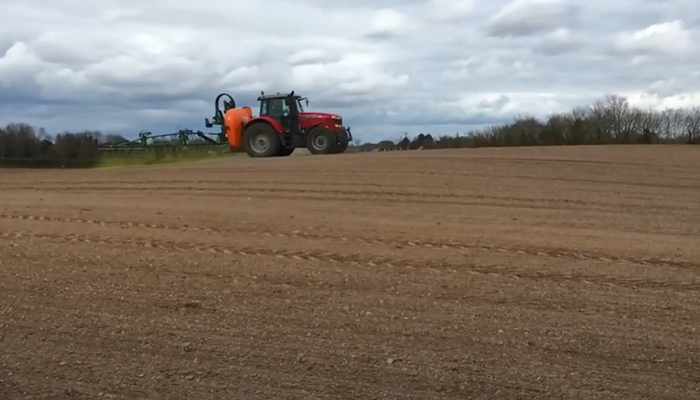25 April 2021
Spraying accurately

Spraying plant protection products (fungicides, insecticides and herbicides) is a critical operation on most crop producing farms. Dermot Forristal, Teagasc Research Officer has practical advice here on application rate, nozzles, correct spraying pressure & forward speed, and developing technology
- The annual spend of a standard programme of plant protection products can vary from €171/ha for spring barley to €292/ha for winter wheat.
- The products must be applied to the crop evenly at the correct rate, with the correct spray quality (droplet size) in the correct volume of water and all at the right time.
- Loss of spray product to the environment through drift, spillages or incorrect sprayer cleaning must be avoided.
There are two decisions to take when applying any plant protection product to ensure that they are applied properly.
Application rate
Firstly the application rate in terms of water volume and the spray droplet size, often denoted as spray ‘quality’, are determined. This is usually with guidance from the spray product label. Many manufacturers are very conservative in this area and automatically default to ‘medium’ or ‘fine’ spray, and application water volumes of 200 litres/ha. In practice growers will often use coarser droplets to reduce drift and lower water volumes to improve workrate and timeliness.
Selection of: nozzles; the correct spraying pressure and forward speed
The second decision is the selection of: nozzles; the correct spraying pressure and forward speed to ensure you achieve precise application. Remember that good quality nozzles, an accurate and easy to read pressure gauge /transducer and accurate forward speed measurement are essential for precise spraying.
Nozzle charts, Phone Apps and Control systems
While nozzle charts can be consulted for forward speed, pressure and nozzle size to give the required application, increasingly, simple-to-use smart-phone Apps allow the correct options to be arrived at. Sprayer control systems may allow you achieve the required application rate automatically by attempting to adjust pressure, but you still must use an App or nozzle chart to choose nozzle type and approximate forward speed and allow the control system correct for variations in forward speed in the field.
Nozzles
Nozzle type and size determine the spray quality (droplet size); the volume to be applied, the evenness of the spray pattern; and the susceptibility to drift. They are available in standard ISO sizes (e.g. blue 03) which will have a standard output (e.g. 1.2 litres per min at 3 bar). This avoids errors in selecting, or replacing nozzles.
Air induction nozzles are the most common, effective and simplest type of drift reduction technology on the market. By drawing in air to mix with the fluid in the nozzle, droplet size is increased and drift is greatly reduced. Air induction nozzles often produce a spray quality coarser than suggested on product labels; however in many cases that this has only a small effect on product performance and may be compensated for by the lack of drift.
The best approach is to have the most common size nozzle fitted to the sprayer in standard and air-induction versions to allow switching between each type when conditions allow. Replace nozzles as a complete set when there is any indication of wear such as increased flow rate (>10% than rated capacity) or uneven spray patterns.
Pressure gauge /transducer and forward speed sensor
An accurate and easy to read pressure gauge is essential. While full testing is best, if a new nozzle gives an incorrect output, it often indicates an inaccurate gauge or transducer. Accurate forward speed indication is also essential and it should be checked; many simple GPS guidance monitors give an accurate speed output.
Sprayer control systems and GPS
Many modern sprayers will have a flow transducer fitted which allows the application rate per hectare to be controlled. These control systems use system pressure to keep the output constant if forward speed changes, so this can impact on spray drift and spray quality. The correct forward speed must still be chosen for the nozzle size and application rate.
Modern sprayers can use the sprayer position, as determined by GPS to turn on and off boom sections, or even individual nozzles, automatically. This can greatly reduce spraying overlaps on field headlands and short ground. These need to be carefully set-up to ensure they work correctly.
Developing technology
Multiple nozzle holders which allow automatic switching of nozzle sizes or the number of nozzles working at one point, on the move, offer a very flexible level of control of application rate. These are available currently and an alternative single nozzle system (pulse width modulation) is also being evaluated. These allow application rate to remain constant when varying forward speed and can even ensure application rate is the same across all areas sprayed by a boom when the sprayer is turning to follow a headland contour. More importantly they will allow variable rate technology to be easily applied in the field, once we have a driver for this technology.
Watch this video as Dermot Forristal and Brendan Burke talk about the importance of nozzle selection and sprayer set up before using a crop sprayer.
Read more on Sprayers and Other Farm Machinery here
